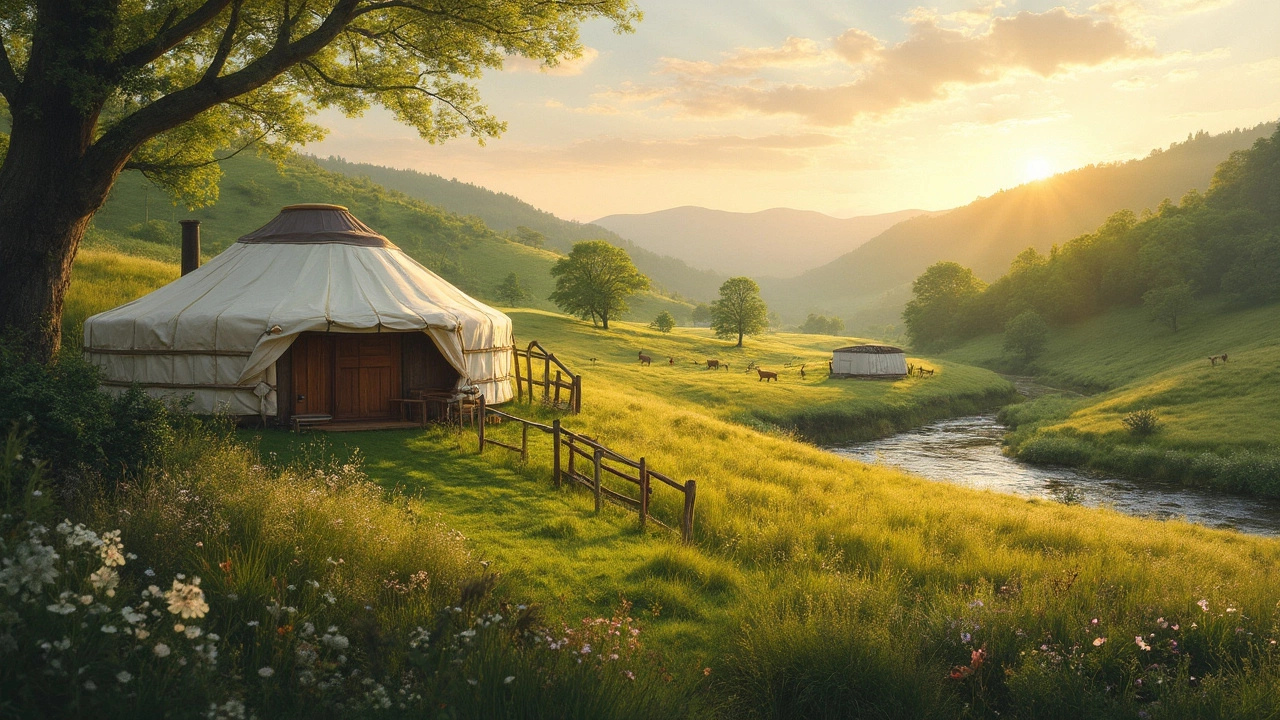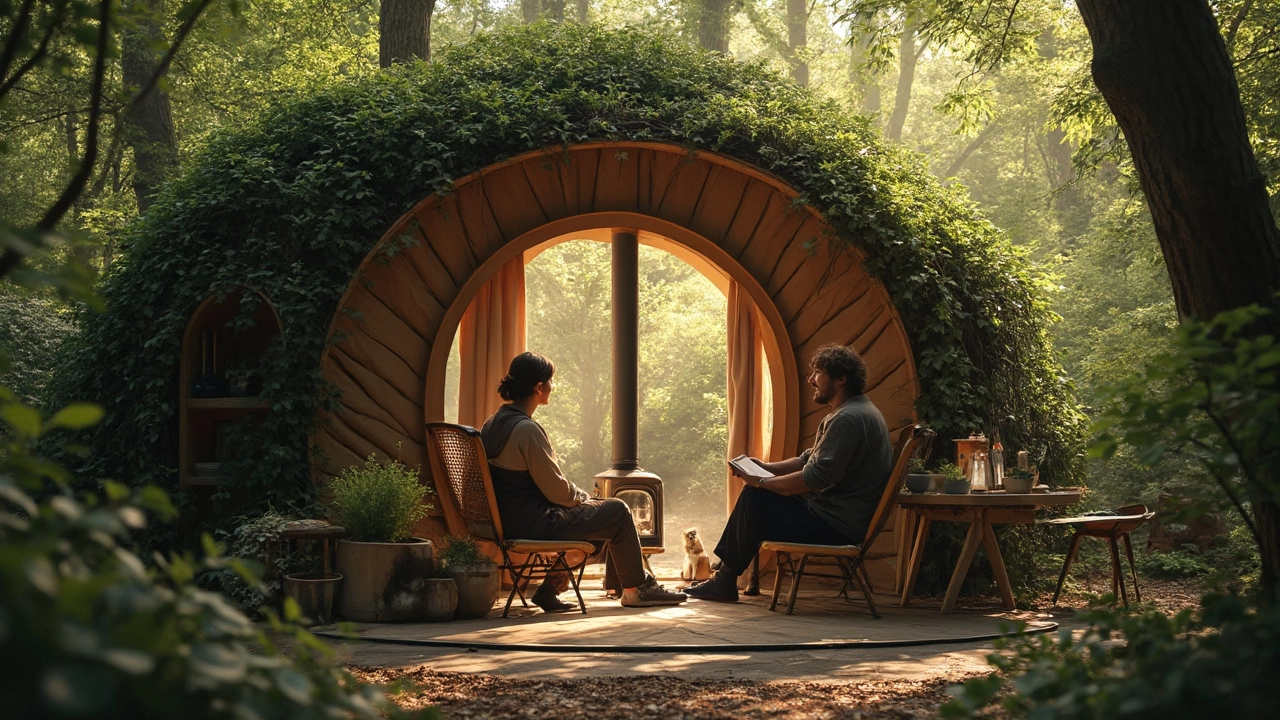Are Yurts Eco-Friendly? Discover the Sustainable Side

Have you ever wondered if living in a yurt could help save the planet? Well, you're not alone. Yurts, those quirky circular tents, are gaining traction as eco-friendly homes, and with good reason. These structures have roots in nomadic traditions but are now embraced by eco-enthusiasts looking for greener living options.
So, what makes yurts eco-friendly? For starters, there's the clever use of materials. Traditional yurts are made from wood, felt, and canvas—materials that are often renewable and sustainably sourced. Modern versions might incorporate recycled or low-impact materials to up their green credentials.
But it's not just about what they're made of. Yurts are generally smaller than traditional homes, meaning they naturally require less energy to heat and cool. Plus, their round shape helps in distributing heat more efficiently, leading to even less reliance on energy-consuming systems.
- What Makes Yurts Eco-Friendly?
- Materials Used in Yurt Construction
- Eco-Benefits of Living in a Yurt
- Tips for Sustainable Yurt Living
What Makes Yurts Eco-Friendly?
Yurts are turning out to be a green living trend for more than just their cozy appeal. One of the biggest reasons they stand out is due to their eco-friendly features.
Renewable and Sustainable Materials
Traditional yurts have been made with materials like wood and felt, which are not just durable but also sustainable. Some modern yurts are crafted with canvas, which is often sourced responsibly or even made from recycled materials. This all ties back to why yurts are a popular choice for those wanting to live lightly on the earth.
Energy Efficiency
The circular shape of a yurt isn't just for aesthetics; it helps with energy savings too. Thanks to physics, warmth circulates better, leading to less energy needed for heating. The small footprint means there's simply less space to heat or cool, which reduces the energy consumption significantly compared to larger, traditional homes.
Minimalist Lifestyle
Your average yurt doesn't have much room for clutter, which often pushes residents towards a more minimalist lifestyle—a win-win situation for saving resources and aligning with sustainable living principles. Instead of accumulating stuff, yurts encourage life in harmony with the environment.
| Feature | Eco-Benefit |
|---|---|
| Material | Renewable and often locally sourced |
| Shape | Efficient in heat distribution |
| Size | Encourages reduced consumption |
Materials Used in Yurt Construction
When it comes to building yurts, it's all about using materials that harmonize with nature. Traditional yurts owe their eco-friendly reputation to their simplicity and reliance on renewable resources.
Wood
Wood is one of the key components in yurt construction. The frame, often known as the khana, is typically made from lightweight, flexible wood like bamboo, or more commonly, willow. These types of wood are chosen because they grow quickly, making them a renewable resource. Some modern yurt builders opt for sustainably harvested Asian or domestic woods to ensure minimal environmental impact.
Canvas and Felt
The outer covering of a yurt is usually a durable fabric like canvas. This material is often chosen because it strikes a great balance between breathability and protection. In climates that see more variation, felt made from sheep's wool might be added for insulation. Wool is not only biodegradable but also naturally water-resistant and a superb insulator.
Innovative Modern Materials
While traditional materials are great for their simplicity, modern yurts might incorporate advanced materials for better durability and reduced environmental impact. Recycled polyester or organic cotton blends for the outer fabric are popular choices, ensuring the yurt remains sturdy while still being kind to the planet.
Eco-Friendly Sealants and Finishes
The finishing touches also matter. Eco-conscious yurt builders often use non-toxic paints, stains, and sealants. These eco-friendly options reduce harmful VOCs (volatile organic compounds), contributing to cleaner air and a healthier living space.
So, when you're considering a yurt, think about how these materials not only contribute to its resilience but also how they keep your ecological footprint in check. It's small design decisions like these that make yurts a compelling choice for sustainable living.

Eco-Benefits of Living in a Yurt
First off, one of the standout eco-benefits of living in a yurt is the minimal environmental footprint. Because of their smaller size and more simplified living, residents often consume less energy. Yurts usually rely less on electricity and heating compared to larger, conventional homes. Many yurt dwellers make use of solar panels or wind turbines to generate their own energy, further cutting down reliance on non-renewable resources.
Now let’s talk about materials. The main materials used in yurt construction—like wood, canvas, and felt—are often sourced sustainably. Wood is usually harvested from managed forests, ensuring that tree cutting is balanced with planting new ones. Meanwhile, modern yurts might use insulation made from recycled textiles, boosting their green appeal.
Sustainable living isn't just about the materials; it's about interaction with the environment too. Yurts can be disassembled easily, leaving almost no trace on the landscape. So if you're the kind that loves relocating or simply want to live lightly, a yurt can adapt without harming its surroundings.
Energy Efficiency
The circular shape of yurts isn't just for aesthetic delight—it’s functional too. This design helps with natural air circulation, maintaining a more consistent temperature inside. Less artificial heating or cooling equals lower energy bills and a happier Earth.
Water Efficiency
For those aiming for off-the-grid living, rainwater collection systems fit perfectly with a yurt lifestyle. You can set up storage tanks to gather rainwater for cleaning and gardening. This captures another form of natural resource and encourages smarter water usage.
In fact, yurt living often inspires a simpler lifestyle overall. It pushes dwellers to prioritize experiences over possessions, inherently reducing unnecessary consumption. As 'stuff' decreases, so does the ecological impact.
Tips for Sustainable Yurt Living
Living sustainably in a yurt goes beyond just setting up your awesome circular abode. It's about making mindful choices that reduce your footprint on our beautiful planet. Here's how you can do just that while enjoying the cozy benefits of yurt life.
1. Energy Efficiency
Yurts are naturally efficient, but let’s take it up a notch. Install solar panels for a renewable energy source that powers your essentials. You can also use LED lighting inside to cut energy consumption.
2. Heating and Cooling
Maximize the eco-friendly benefits by using a wood-burning stove or a small pellet stove. Both options not only provide heat but also create a snug atmosphere. In the summer, proper ventilation and strategic window placement can keep things cool using cross-breezes.
3. Water Conservation
Rainwater collection is a practical method for yurts. Set up gutters to channel rainwater into collection barrels. You can use this water for gardening or other non-potable uses, conserving your primary water supply.
4. Insulation
Keep your yurt cozy all year long by choosing the right insulation. Wool felt is a traditional and effective option, but modern materials like recycled denim are also great eco-friendly choices.
5. Off-the-Grid Living
If you're going for the full experience, consider composting toilets and gray water systems. These systems help manage waste without relying on existing infrastructure, making them perfect for remote yurt locations.
6. Sustainable Furnishing
Furnish your yurt with second-hand or sustainably-sourced furniture. Not only does this save resources, but it also gives your yurt a unique, personalized touch with treasures that come with stories.
Eco-friendly Impact Statistics
Curious about the impact of your sustainable moves? Check out this quick comparison of energy savings:
| Option | Energy Reduction |
|---|---|
| LED Lighting | Up to 75% less energy |
| Solar Panels | Reduces reliance on traditional grid by up to 50% |
Living in a yurt isn’t just cute, it's a real step towards a sustainable living. Each little change you make contributes to a greener planet and a more fulfilling lifestyle. So go ahead, embrace the yurt life and feel good about doing your part!